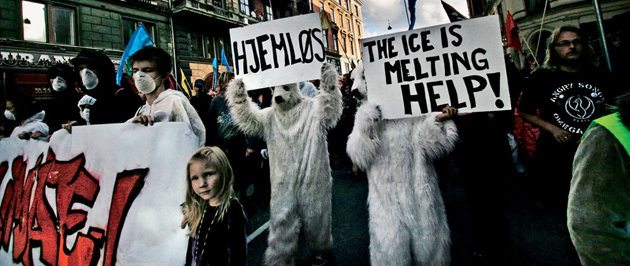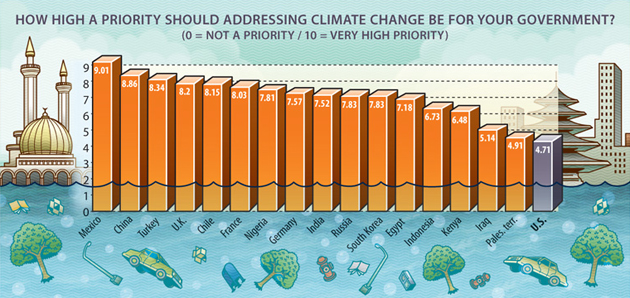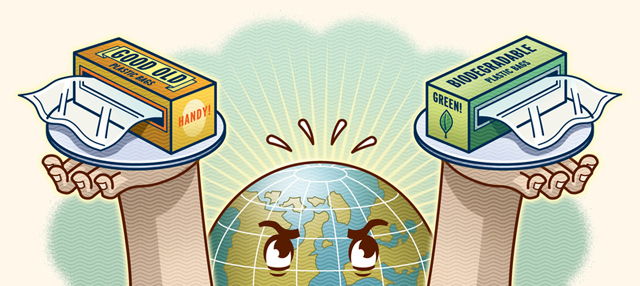sierraclub.org - sierra magazine - november/december 2009 - grapple


Grapple | With Issues and Ideas
Clash of the Titans | Up to Speed | Burning Brighter | What, Us Worry? |
As the World Warms | Woe Is Us | Backyard Dioxin Factories
Clash of the Titans:
The United States and China need to come to terms if Copenhagen is to succeed

A pre-conference demonstration in Copenhagen by homeless polar bears and other concerned parties.
In December, delegates from nearly 200 countries will gather in Copenhagen to replace the United Nations' Kyoto Protocol and save the planet from global warming.
At least, that's the hope. But it will require the world's two biggest emitters of greenhouse gases, China and the United States, to stop waiting for the other to ante up first. The United States wants China to commit to hard targets. China says that, as a developing nation, it can't--but the United States should cut emissions 40 percent below 1990 levels by 2020. (In comparison, the climate bill passed by the House this summer would require only a 4 percent reduction in that same period.)
U.S. negotiator Todd Stern says that even if every other nation in the world reduced its emissions by 80 percent between now and 2050, "China's emissions under business-as-usual assumptions would alone be so large as to put us on a track to global concentrations of 540 parts per million of carbon dioxide"--far into the danger zone.
Nevertheless, pre-Copenhagen talks between the two giants have been productive. Rather than insisting that China agree to carbon caps, the United States is now focusing on getting China and other developing countries to take specific actions, such as reducing energy consumption per unit of GDP. Binding actions may end up substituting for binding targets.
Meanwhile, tropical nations like Indonesia, Mexico, and Brazil are focusing on deforestation, which accounts for a fifth of all global-warming emissions. Specifically, they want to be rewarded for keeping their forests intact. All sides agree that doing so is crucial, but environmentalists fear that industrialized nations might see investment in rainforests as a ticket out of serious emissions reductions.
Most observers say that they'll consider Copenhagen a success if it creates momentum for resolving the thornier issues. "It doesn't have to be the once-and-for-all, saves-the-planet, puts-us-on-the-right-track-for-the-next-50- years agreement," says Doug Boucher of the Tropical Forest and Climate Initiative at the Union of Concerned Scientists. "On the other hand, just an agreement that expresses good wishes for the planet is not enough." —Dashka Slater
Burning Brighter
 The Siberian tiger is making its second comeback. From a low point of 40 cats in 1940, its numbers were boosted to more than 500, thanks to postwar protection by the Soviet Union. But after the USSR's collapse, poachers killed off more than half that population, mainly to supply the lucrative market in traditional Chinese medicine, which attributes Viagra-like powers to tiger parts.
The Siberian tiger is making its second comeback. From a low point of 40 cats in 1940, its numbers were boosted to more than 500, thanks to postwar protection by the Soviet Union. But after the USSR's collapse, poachers killed off more than half that population, mainly to supply the lucrative market in traditional Chinese medicine, which attributes Viagra-like powers to tiger parts.
Tiger poaching has dwindled, however, since China started enforcing strict penalties for the practice, including death. Also helping are the anti-poaching patrols and education programs sponsored by various conservation groups, including the Phoenix Fund.
These days, with fewer direct threats to the world's largest cat, the group's patrols focus on preventing hunters from poaching tigers' prey. "If we can protect its habitat and prey, we're optimistic that the tiger will survive," says Phoenix Fund director Sergei Bereznuk. He estimates that some 400 adults and 500 cubs now roam the forests of Siberia, close to the 700 adult tigers biologists say will ensure a stable population. —Sarah F. Kessler
What, Us Worry?

U.S. representatives to the United Nations climate-change conference in Copenhagen may want to go incognito. It now appears unlikely that the Senate will pass a strong climate-protection bill in time for the pivotal December summit. Moreover, the slacker mentality that grips Congress extends to the general populace: A survey of 19 countries by the University of Maryland's Program on International Policy Attitudes finds that Americans rank dead last when it comes to backing action on climate change. Most other nations show strong popular support for tough government action. Despite Britain's already substantial efforts, 77 percent of Britons think their government should do even more. At the opposite end of the spectrum, only the residents of the Palestinian territories and Iraq are as lackadaisical as us. --Paul Rauber
AS THE WORLD WARMS:
Quick thinking before we slowly fry
FORGING ALLIANCES In the run-up to the House vote on climate-change legislation, several representatives received letters from the NAACP urging them to vote no. The NAACP, however, supports getting tough on climate change. Turns out the missives were forgeries penned by "Astroturf" (fake grassroots) specialists Bonner and Associates, which had been hired by a consultant for the American Coalition for Clean Coal Electricity. Bonner blamed the deception on a "temporary employee."
MILE-HIGH CLUB The mileage requirements in the federal Cash for Clunkers program were pretty paltry: Consumers could get the $3,500 rebate for cars that got a mere four miles per gallon more than their "clunker." The government's figures showed most participants opting for cars with a higher mpg than required; there was an overall average improvement of 9.2 miles to the gallon for cars purchased through the program.
POWER TO THE PEE-PLE Droughts are raging in China, Paraguay, and Australia, and climate scientists predict more to come. The Brazilian environmental group SOS Mata Atlantica has a whiz of a solution: It's launched an animated TV spot) promoting urinating in the shower. By skipping one flush a day, the group says, multitaskers can save 1,157 gallons of water annually. The slogan (it sounds better in Portuguese): "Pee in the shower! Save the Atlantic rainforest!" —D.S.

ON THE ONE HAND...
It's the beginning of the end for the ubiquitous, nearly immortal plastic bag. People use more than half a trillion of them each year, recycling less than 5 percent. But laws prohibiting or taxing plastic bags have had dramatic effects everywhere they've been instituted. China reduced plastic-bag use by two-thirds when it banned their production last year; in Ireland, a charge equal to 30 cents per bag has cut use by 94 percent. Other locales spurning plastic include Italy, Kenya, South Africa, Los Angeles, Taiwan, and Mumbai.
ON THE OTHER...
The biodegradable and compostable sacks touted as "ecofriendly" plastic-bag substitutes have their own problems. Biodegradable bags are made from petroleum and can leave a toxic residue when they break down. Compostable bags are made from vegetable starches, but the vegetables probably need petroleum-based fertilizers to grow. When the bags decompose in a landfill, they produce methane, a greenhouse gas 20 times more potent than carbon dioxide. And disposable bags of any sort can clog waterways and harm wildlife. The problem with disposable bags is not just the material; it's the disposability. —D.S.
Woe Is Us: Ready, set, panic.
BAT DOOMSDAY
 Bats eat many tons of mosquitoes a year. Better dust off the DEET, because a thus-far-incurable malady is destroying bat colonies in the northeastern United States and is moving south and west. Named for the telltale fungus on their muzzle, "white-nose syndrome" strikes bats as they hibernate in caves and mines and has wiped out 90 to 100 percent of some colonies.
Bats eat many tons of mosquitoes a year. Better dust off the DEET, because a thus-far-incurable malady is destroying bat colonies in the northeastern United States and is moving south and west. Named for the telltale fungus on their muzzle, "white-nose syndrome" strikes bats as they hibernate in caves and mines and has wiped out 90 to 100 percent of some colonies.
David Blehert, a researcher at the National Wildlife Health Lab in Madison, Wisconsin, says the fungus, Geomyces destructans, looks like what you see on "a forgotten tub of cottage cheese in the back of your refrigerator." Blehert's lab has documented bat-to-bat transmission, but humans can also be vectors, so cavers are being asked to stay out of infected areas. "Humans have the capability for moving around the world in ways that bats don't," he says.
Scientists have no idea where the disease originated; they can only try to slow its spread. "This will not be the end of the world," says West Virginia Division of Natural Resources wildlife biologist Craig Stihler, "but it's going to change the world." Watch Stihler in the short film The Battle for Bats.
SECOND MANHATTAN
A hunk of ice larger than Manhattan is breaking away from northwestern Greenland. The 5-billion-metric-ton block serves as a plug to the huge Petermann Glacier; once it drifts off, the glacier will flow out to sea even more rapidly. Grab your wellies: Melting glaciers are prime contributors to sea-level rise.
—P.R.
Backyard Dioxin Factories:
Household "burn barrels" are major toxic polluters
Is that the smell of dioxin on the morning breeze? Don't be too quick to blame the neighborhood chemical factory, coal-fired power plant, or garbage incinerator, because it may well be coming from your own backyard. According to the EPA, the burning of household trash (commonly done in a "burn barrel") accounts for 32 percent of all U.S. releases of carcinogenic dioxin. By comparison, coal plants account for 4.5 percent and municipal incinerators 5 percent.
Surveys by the EPA and others estimate that between a quarter and a half of rural Americans burn some or all of their trash. Hauling trash to the nearest transfer station often requires driving long distances, plus paying for disposal. Even where trash pickup is available, many folks don't want to pay for it. In addition, burning trash is something of a tradition, part of the rural culture of self-sufficiency and pragmatism.
Most of the dioxin from burning trash comes from petroleum-based plastic and polystyrene, which also releases benzene, lead, arsenic, and PCBs into the air. But even seemingly harmless trash like paper and cardboard emit dioxins when burned. Exposure to such smoke can irritate lungs, alter the immune system, and cause birth defects. When dioxin lands on plants that are later consumed by livestock, it bioaccumulates and is passed on to those who eat meat, eggs, and dairy products. And the ashes created by burning trash are a toxic soup of their own, contaminating soil and leaching into drinking-water sources.
Some states have outlawed open trash burning;
New York may be next. Too often, though, regulation is left to local authorities--who often burn trash themselves.
—Jeremy Jackson
Photos and illustrations, from top: Mimo, Tim Fitzharris, Peter and Maria Hoey (2).